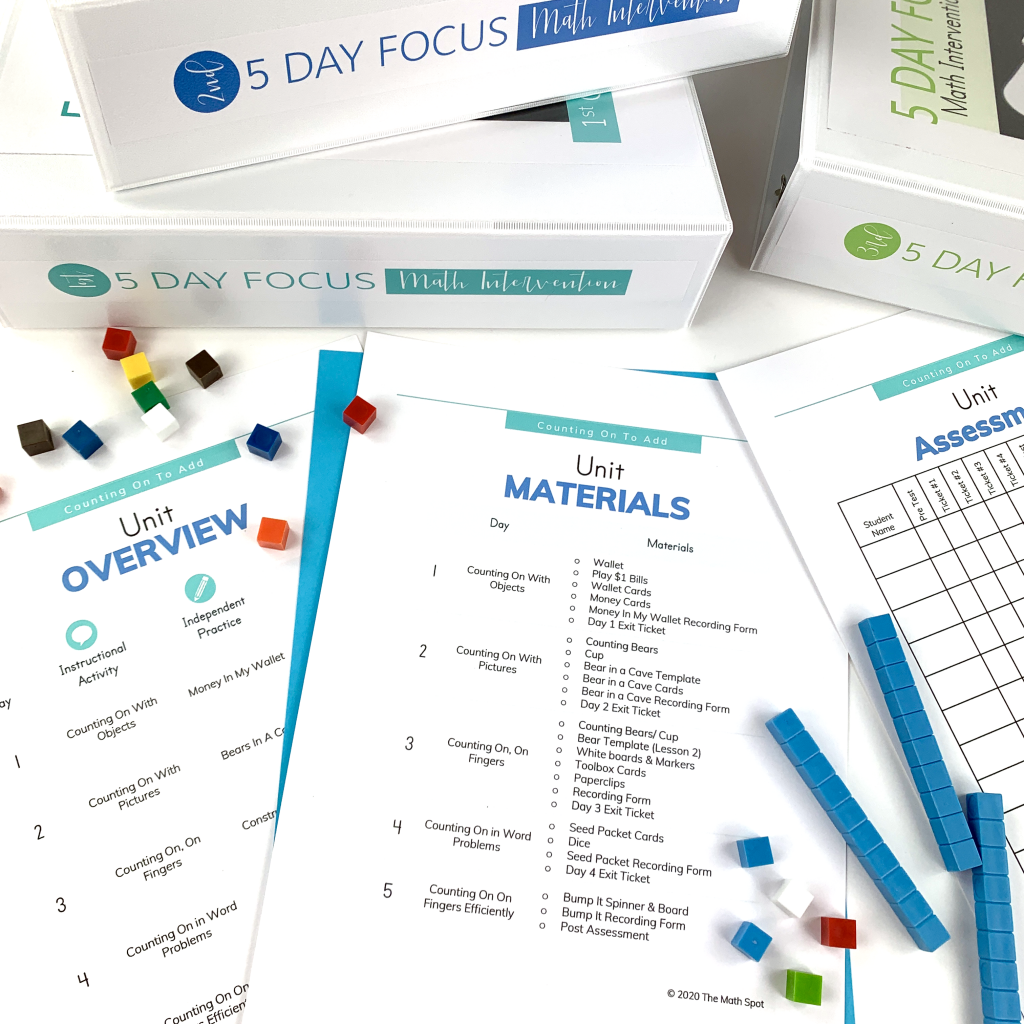This post contains affiliate links. This means that when you make a purchase, at no additional cost to you, I will earn a small commission.

You might be a classroom teacher looking to implement a math intervention strategy for the upcoming school year.
Or maybe you’re in an intervention position but you are overwhelmed by the wide array of math research on best practice.
Or maybe you are a special education teacher but you are looking to improve the math intervention strategy in your program.
In any case, getting focused on your math intervention strategy will help your students to close gaps in their understanding and put them on a path where they, hopefully, won’t need comprehensive math intervention in the future!
Math Intervention Strategy #1: Choose a Target
Your interventions need to be targeted around a specific skill or need. The best way to make this work is to screen students either through a screening tool or regular classroom assessments.
If you are in a special education or math intervention setting, you are likely delivering tier 3 services. This means that you are closing gaps and filling in skills that were missed in previous grade levels. There may be a seemingly endless amount of ground to cover but focus in on place value and understanding of operations. Delve as far back into these two areas as needed to find your starting place.
If you are in the classrom you may have students who have gaps from previous grade levels but, more than likely, as the year progresses you will have students working on skills that were learned that year but not yet mastered. Your regular classroom assessments can help you to determine exactly which skills you need to focus on with your students.
Math Intervention Strategy #2: Think CRA
CRA refers to the concrete, representational, abstract progression of learning. When you are planning math interventions, keep this progression top of mind!
For example, perhaps you have a group of students who working towards proficiency in the counting on strategy. You might start by using counting bears. Some bears are in a cup and the rest are outside. You practice finding the total by starting at the number of bears in the cup and counting on to find the total.
When your students are consistently able to demonstrate an understanding of this skill using a hands-on model, you might ask your students to draw a picture that matches the scenario. Maybe your students draw a 3 with a circle around it to represent the bears in the cup and then draw 4 more dots to represent the bears outside of the cup. They can then count to find the total.
Bringing in the abstract might mean that you are providing your students with a story problem or equation and asking them to use the counting on strategy to solve.
CRA is NOT an entirely linear strategy and these few paragraphs are simplifying- perhaps overly so. Thinking CRA while planning math intervention, however, is a critical step to building a path to proficiency for your students.
Math Strategy #3: Layer on Number Sense
I’ve heard it more times than I can count…
“We’re taking a break to work on their number sense…”
“My lowest group is my ‘number sense’ group…”
While well-intentioned, this approach just will not work!
When we look at our students requiring math intervention, it is true that number sense is often lacking, but you can’t simply “teach number sense”. Instead, strive to illuminate number sense relationships inside of your math intervention lessons.
Ex: You are working on the skill of finding a number that is 10 more or 10 less than a given number. You can both improve that skill AND boost number sense by using a visual such as a place value drawing. When your students can visually see what it looks like to add ten to 43, for example, they are improving their spatial relationships around two-digit numbers.
Whenever possible, strive to use visual models and leverage number relationships inside of your skill instruction.
Math Intervention Strategy #4: Fold in Fact Fluency
Much like number sense, you don’t need to stop your regular skill instruction to work on fact fluency.
*As a caviat, your students WILL need dedicated time and opportunity to practice and apply facts so that they do become fluent and move the facts to longterm memory.
Fact fluency is much more complex than knowing facts from memory. Fact fluency is about leveraging fact relationships so that there are, ultimately, fewer facts to learn and memorize.
Rather than learning over 200 individual addition and subtraction facts, your students will focus on relationships. One more facts, one less facts, doubles, near doubles, partners of ten, etc.
Again, much like number sense, whenever possible, fold these relationships into your math intervention instruction!
Math Intervention Strategy #5: Prioritize Small Group Math Time!
If your math intervention strategy does not include dedicated time to work with small groups of students it will not work.
If you are not implementing a math intervention strategy, your most struggling students will continue to struggle.
It’s that simple.
Just as you prioritize reading groups at your students’ instructional level you MUST dedicate time to supporting your students at their current level of understanding in math as well.
Ready to Get Started?

I have put together math units that include everything you need to implement math intervention lessons that work.
- Pre and post-assessment
- Daily lessons
- Independent practice
- Progress monitoring
Feel prepared and confident that you will be able to meet your students needs without giving up your nights and weekends to planning and preparation!
Kindergarten | 1st Grade | 2nd Grade | 3rd Grade | 4th Grade




